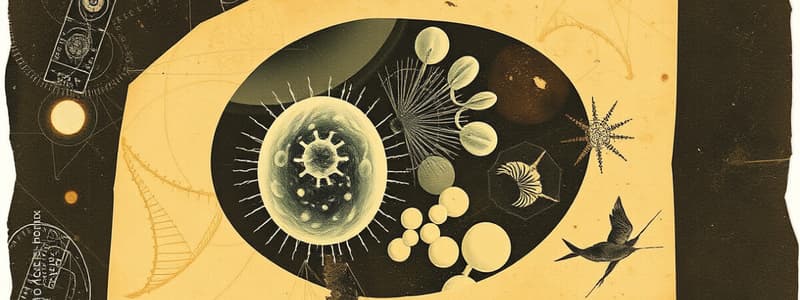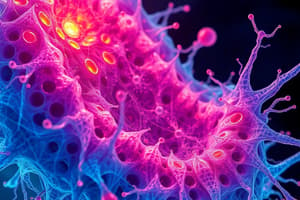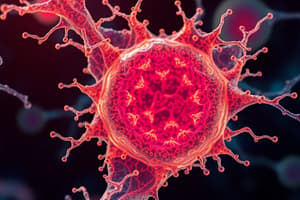Podcast
Questions and Answers
What is the primary function of the rough endoplasmic reticulum (ER)?
What is the primary function of the rough endoplasmic reticulum (ER)?
- Digestion of waste materials
- Transportation of lipids
- Storage of carbohydrates
- Distribution of proteins (correct)
Which organelle is primarily responsible for packaging materials to be secreted from the cell?
Which organelle is primarily responsible for packaging materials to be secreted from the cell?
- Golgi complex (correct)
- Lysosomes
- Smooth ER
- Mitochondria
What role do lysosomes play in the cell?
What role do lysosomes play in the cell?
- Power production
- Digestion of materials (correct)
- Storage of nutrients
- Protein synthesis
What is the main energy molecule produced by the mitochondria?
What is the main energy molecule produced by the mitochondria?
Which structure within the nucleus is responsible for the formation of ribosomes?
Which structure within the nucleus is responsible for the formation of ribosomes?
What is the primary purpose of vacuoles in a cell?
What is the primary purpose of vacuoles in a cell?
Who first discovered the cell and what did he compare it to?
Who first discovered the cell and what did he compare it to?
What fundamental principle of biology was established by Schwann, Schleiden, and Virchow?
What fundamental principle of biology was established by Schwann, Schleiden, and Virchow?
Which of the following components does the cell membrane NOT perform?
Which of the following components does the cell membrane NOT perform?
What is the primary function of centrioles within the cell?
What is the primary function of centrioles within the cell?
What distinguishes rough endoplasmic reticulum from smooth endoplasmic reticulum?
What distinguishes rough endoplasmic reticulum from smooth endoplasmic reticulum?
Which of the following statements is NOT part of Cell Theory?
Which of the following statements is NOT part of Cell Theory?
In what capacity does the cytoplasm function within the cell?
In what capacity does the cytoplasm function within the cell?
Which structure plays a vital role in cell division by forming spindle fibers?
Which structure plays a vital role in cell division by forming spindle fibers?
Flashcards are hidden until you start studying
Study Notes
Cell Fundamentals
- Cells are the smallest and most vital structures in any organism, responsible for all biological processes essential for life.
- Robert Hooke discovered cells in 1665 while studying corks, naming them for their resemblance to monastery rooms.
- Theodor Schwann (zoologist) and Matthias Schleiden (botanist) proposed that cells are the basic building blocks of all living organisms.
- Rudolf Virchow established that cells arise only from pre-existing cells through cell division.
Cell Theory
- The Cell Theory includes key principles:
- Cells are the structural and functional units of living things.
- All organisms consist of one or more cells.
- All cells originate from pre-existing cells.
Cell Structure and Functions
- The cell is enclosed by a semi-permeable cell membrane (plasma membrane) that regulates material movement in and out of the cell.
Cytoplasm and Organelles
- Cytoplasm, also known as protoplasm, is the living substance of the cell, containing essential chemical elements and organelles that perform metabolic activities.
Key Organelles
- Centrioles: Located in centrosomes; involved in microtubule production and spindle fiber formation for cell division.
- Endoplasmic Reticulum (ER): Functions as the cell's circulatory system; consists of:
- Rough ER (rER): Studded with ribosomes, involved in protein distribution.
- Smooth ER (sER): Transports materials other than proteins, such as carbohydrates and lipids.
- Golgi Complex: Acts as the packaging and secretory system of the cell, collecting materials for disposal through secretory vesicles.
- Lysosomes: Often called "suicide sacs," they contain enzymes (lysozymes) for digestion.
- Mitochondria: Known as the "powerhouse" of the cell, they produce Adenosine Triphosphate (ATP) as the primary energy source.
- Ribosomes: Spherical and non-membranous, crucial for protein synthesis.
- Vacuoles: Serve as storage for various materials within the cell.
Nucleus
- The nucleus is regarded as the "brain of the cell," controlling all metabolic activities.
- Contains nucleoplasm and is enclosed by a double membrane (nuclear membrane).
- Houses chromosomes that contain genetic material (DNA) and includes the nucleolus, which is involved in ribosome formation.
Studying That Suits You
Use AI to generate personalized quizzes and flashcards to suit your learning preferences.




